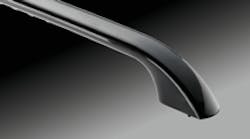Get High-Gloss Parts with Reinforced Polyester Resin and Gas-Assisted Injection Molding
Authored by: Adalberto Trejo Edited by Jessica Shapiro Key points: Resources: |
Need a high-gloss plastic part? If your part is rod-shaped or large and flat with structural ribs, or if it’s a complex mix of thick and thin walls, don’t discount weight-saving gas-assist injection molding.
Gas-assist injection molding (GAIM) is a method of pressurizing an injection-molded part with gas to provide extra packing force. The gas forms a hollow cavity inside the part via a network of flow channels or by direct injection. GAIM’s advantages include the ability to cut part weight and material cost, the ease of combining parts with different wall thicknesses into a single design, and the reduced press capacity needed to produce fully consolidated parts.
Until recently, engineers avoided the technique for parts that needed high-gloss surfaces. Now molding vendors combine tooling, process controls, and materials that produce strong, high-gloss parts that are lighter and more economical than those from traditional injection molding.
Gas-assist process
GAIM starts when the mold closes and an injection nozzle shoots a precise quantity of molten resin into the mold. Although the resin does not completely fill the cavity, the screw feeding the nozzle bottoms out before returning to its initial position.
After a preset delay, the system injects pressurized inert gas — usually nitrogen with 99% or greater purity — into the melt. The system holds the gas pressure in the part for the entire packing and cooling phases, and then vents the gas before the mold opens for part removal.
Experienced molders can advise engineers on the suitability of GAIM for their parts. In general, however, the technique works for three categories of molded parts: tubes or rods like handles or clutches; large, cover-shaped parts with stiffening ribs; and complex parts that combine thick and thin walls in a single design.
The isostatic pressure provided by the nitrogen gas is what lets thin and thick walls fill completely in a single part. For cover-shaped parts, gas channels combine with the rib structure to boost strength without adding significant weight.
In tube or rod-shaped parts, the part effectively is the one-dimensional gas channel. Tube-wall thickness depends on melt viscosity and temperature distribution when gas is injected, as well as on gas pressure. Changes in any of these can affect wall uniformity, so a close watch on these variables is imperative.
Getting gloss
For many parts, surface appearance is as important as physical integrity. Gloss — a surface’s ability to reflect directed light — is often used to evaluate appearance. Current styling trends lead appliance OEMs to specify high-gloss parts and automotive OEMs to request low-gloss.
Molders and OEMs use reflectometers to objectively evaluate gloss based on reflection behavior. Part gloss is compared to a highly polished black glass with a refractive index of 1.567. The glass is assigned a reference specular gloss value of 100 for each illumination angle considered: 20, 60, or 85°. Instrument and standard tolerances are tightly controlled so measurement error is ±1 unit or less.
Three factors typically affect gloss: mold-surface finish, processing parameters, and the material being molded. To get a truly high-gloss part without additional processing, OEMs and molders should address all three.
A polished-steel tool surface transfers its high-gloss finish to the plastic during molding. Although relying solely on mold texture can be costly in terms of tool maintenance and insufficient to meet high-gloss requirements, it is an important aspect of high-gloss part production.
During processing, higher mold temperatures lead to glossier parts when resin is filled with glass fibers or other reinforcements. However, boosting mold temperature means extending cooling times and, consequently, raising part costs.
For glass-fiber-reinforced resins, holding pressure — or gas-packing pressure in the case of GAIM — is an important process parameter, too.
Special resin formulations can ensure parts meet aesthetic and performance requirements when tool modifications and processing conditions alone are not enough or are too costly.
For example, Ticona developed a 15% glass-filled polybutylene terephthalate (PBT)/polyethylene terephthalate (PET) blend for an appliance handle. The raw material is economical, has a 760-mm flow that permits molding of long channels, doesn’t require longer cycles to develop high gloss, is colorable, and maintains a good balance of mechanical properties.
The blend lets PET, commonly found in clear disposable beverage bottles, reach the surface before PBT, which is more commonly used for its engineering properties. The PET surface layer crystallizes in the hot mold to form a glossy surface. Specially formulated color additives contribute to part gloss while tinting the part to the OEM’s desired shade.
The “show” side (the side customers see) of GAIM parts molded with the blend had 86.7% the gloss of the glass standard at 60°. Conventionally injection molded parts achieve 90 to 100% gloss while GAIM parts molded without optimized resins only reach 55% gloss.
Finished parts are UV-stable under indoor lighting and resist scratches, stains, detergents, cleaners, and chemicals. They have good mechanical strength and creep resistance despite being lighter than traditionally injection-molded parts.
About the Author
Jessica Shapiro
Jessica serves as Associate Editor - 3 years service, M.S. Mechanical Engineering, Drexel University.
Work experience: Materials engineer, The Boeing Company; Primary editor for mechanical and fastening & joining.
